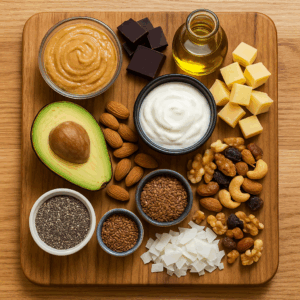10 Surprisingly High-Calorie Healthy Foods That Can Stall Fat Loss
When most people think of weight gain, they picture foods like Reese’s Peanut Butter Cups or a big slice of pizza. But what often goes unnoticed is that many high-calorie healthy foods can quietly push your calorie intake far beyond what you realize.
To be clear: these foods are nutritious, full of healthy fats, fiber, and micronutrients. But when it comes strictly to calorie totals, your body treats 300 calories of nuts the same as 300 calories of candy. And if fat loss is your goal, calories still matter—no matter where they come from.
This is why understanding high-calorie healthy foods is so important. Not to avoid them, but to use them intentionally.
Why High-Calorie Healthy Foods Can Slow Fat Loss
When you’re trying to lose fat, your primary goal is to maintain a calorie deficit—eating fewer calories than your body burns. The challenge? Some of the healthiest foods are so calorie-dense that small portions add up quickly.
These foods don’t feel indulgent, which makes them easy to overeat. You don’t get the same “guilty” feeling you might get from snacking on candy, but the calorie impact is nearly identical.
Let’s break down the top high-calorie healthy foods that tend to surprise people.
1. Nuts & Nut Butters
Nuts are nutritious, but incredibly calorie-dense.
-
1 handful (1 oz) almonds = ~170 calories
-
2 tbsp peanut butter = ~190–200 calories
They’re delicious, easy to snack on, and often eaten mindlessly straight from the bag.
2. Avocado
People love avocado for its healthy fats, but it’s one of the most calorie-dense whole foods.
-
1 medium avocado = ~250–300 calories
Spread it on toast, add it to bowls, or top a salad—and your meal’s calorie total climbs fast.
3. Seeds (Chia, Flax, Sunflower, etc.)
Seeds are tiny nutrient powerhouses—but also high in calories.
-
2 tbsp chia or flax = 110–120 calories
Because they’re small, people tend to add them without measuring.
4. Cheese
Cheese is satisfying, but not very filling per calorie.
-
1 oz (pair of dice) = ~110–120 calories
And let’s be honest: nobody eats just one ounce—especially when it’s melted.
5. Dark Chocolate
Often marketed as a “healthier treat,” dark chocolate still packs a punch.
-
1 oz = ~150–170 calories
A few squares can add up quickly without much fullness.
6. Coconut & Coconut-Based Products
Coconut oil and full-fat coconut milk are extremely calorie-dense.
-
1 tbsp coconut oil = 120 calories
-
1 cup full-fat coconut milk = 400+ calories
Common in smoothies and curries, these calories sneak up fast.
7. Olive Oil & Other Healthy Oils
One of the easiest ways to add accidental calories to meals.
-
1 tbsp = 120 calories
That “little drizzle” on your salad can easily turn into 200–300 calories.
8. Full-Fat Yogurt & Milk
Great taste, but higher in calories than people expect.
-
1 cup whole milk = 150 calories
-
1 serving full-fat yogurt = 180–250+ calories
Add granola or honey and you’re looking at a 350–400 calorie snack.
9. Trail Mix
A classic “healthy snack” that often works against fat loss.
-
1 small handful (1.5 oz) = 200–250 calories
Most blends include nuts, dried fruit, chocolate, and seeds—making it calorie-dense and not very filling.
10. Smoothies & Bowls with Hidden High-Calorie Foods
This one is sneaky. Smoothies often include multiple high-calorie healthy foods like nut butters, seeds, coconut milk, yogurt, and avocado—all in one drink.
You think you’re grabbing a “light healthy snack,” and suddenly it’s 500–700 calories.
Why This Matters for Fat Loss
Fat loss happens when your daily calorie intake is lower than your calorie burn. The issue with high-calorie healthy foods is that they don’t trigger the same caution that treats or desserts do.
You may feel like you’re making great choices—and you are—but calories still accumulate. If you accidentally overeat these foods throughout the day, fat loss can stall quickly.
What To Do Instead (Simple Actions That Work)
You don’t need to eliminate these foods. They’re nutritious and can absolutely be part of a healthy diet. Instead, try these simple, effective strategies:
Measure Your Portions
Eyeballing is almost always inaccurate. Use a tablespoon, food scale, or measured scoop.
Use Calorie-Dense Foods Inside Meals, Not As Snacks
You’re less likely to overeat when these foods are part of an actual meal.
Prioritize High-Volume, Lower-Calorie Foods
Fruits, veggies, and lean proteins are more filling per calorie.
Be Honest About Oils, Nuts, and Spreads
These are the sneakiest sources of extra calories.
Final Thoughts
You don’t need to label foods as “good” or “bad.” Instead, build awareness around high-calorie healthy foods and use them intentionally. When you understand which foods pack the most calories, you can stay in better control of your goals without feeling restricted.

